In order to have some control over how the images are painted, I'd recommend creating an own panel for that, and use drawImage calls in the overridden paintComponent method. The "location" of the image should preferably be a relative value - that is, a double value between 0.0 (showing the first image) and 1.0 (showing the second image) to be independent of the resolution and image size.
There is a caveat regarding the image size, though: One has to assume that the size of both images is the same. Otherwise, you're opening a can of worms regarding the question of how different image sizes should be handled. Additionally, there are some degrees of freedom what should happen when the containing component is larger or smaller than the images. But for simplicity, one can assume that it has always the right size.
A simple implementation could then look like this:

And here's the corresponding code:
import java.awt.BorderLayout;
import java.awt.Color;
import java.awt.Dimension;
import java.awt.Font;
import java.awt.Graphics;
import java.awt.Graphics2D;
import java.awt.image.BufferedImage;
import javax.swing.JFrame;
import javax.swing.JPanel;
import javax.swing.JSlider;
import javax.swing.SwingConstants;
import javax.swing.SwingUtilities;
public class ImageSlideTest
{
public static void main(String[] args)
{
SwingUtilities.invokeLater(() -> createAndShowGui());
}
private static void createAndShowGui()
{
JFrame f = new JFrame();
f.setDefaultCloseOperation(JFrame.EXIT_ON_CLOSE);
BufferedImage image0 = createImage("Image 0", Color.RED);
BufferedImage image1 = createImage("Image 1", Color.GREEN);
ImageSlidePanel imageSlidePanel = new ImageSlidePanel(image0, image1);
JPanel panel = new JPanel(new BorderLayout());
panel.add(imageSlidePanel, BorderLayout.CENTER);
JSlider slider = new JSlider(SwingConstants.VERTICAL, 0, 100, 0);
slider.addChangeListener(e ->
{
double location = slider.getValue() / 100.0;
imageSlidePanel.setLocation(location);
});
panel.add(slider, BorderLayout.EAST);
f.getContentPane().add(panel);
f.pack();
f.setLocationRelativeTo(null);
f.setVisible(true);
}
private static BufferedImage createImage(String text, Color color)
{
int w = 300;
int h = 200;
BufferedImage image =
new BufferedImage(w, h, BufferedImage.TYPE_INT_ARGB);
Graphics2D g = image.createGraphics();
g.setColor(color);
g.fillRect(0, 0, w, h);
g.setColor(Color.BLACK);
g.setFont(new Font("Dialog", Font.PLAIN, 30));
g.drawString(text, 50, 50);
g.dispose();
return image;
}
}
class ImageSlidePanel extends JPanel
{
private final BufferedImage image0;
private final BufferedImage image1;
private double location;
// Note: The images should have the same size...
public ImageSlidePanel(BufferedImage image0, BufferedImage image1)
{
this.image0 = image0;
this.image1 = image1;
this.location = 0.0;
}
public void setLocation(double location)
{
this.location = Math.min(1.0, Math.max(0.0, location));
repaint();
}
@Override
protected void paintComponent(Graphics g)
{
super.paintComponent(g);
int dx = (int) (image0.getWidth() * location);
g.drawImage(image0, -dx, 0, null);
g.drawImage(image1, -dx + image0.getWidth(), 0, null);
}
@Override
public Dimension getPreferredSize()
{
if (isPreferredSizeSet())
{
return super.getPreferredSize();
}
int w = image0.getWidth();
int h = image0.getHeight();
return new Dimension(w, h);
}
}

